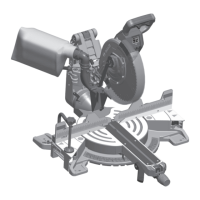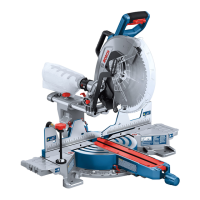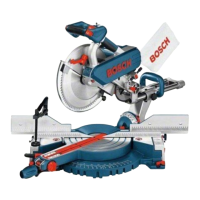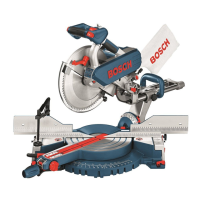29
Adjusting Bevel Lock Tension
CHECKING BEVEL LOCK TENSION
1. Pull up the bevel lock lever to release
tension. If it feels too hard to pull up, an
adjustment may be required.
2. Check the tilt resistance. Grab main han-
dle and slowly tilt the saw to the left.
While tilting, some resistance should be
felt. At approximately 30°, the resistance
should become lower. If little or no re-
sistance is felt, an adjustment may be re-
quired.
3. Check bevel lock tension. Push down on
the bevel lock lever – normally more
pressure is needed at the start; then the
lever should go fully down to the lock po-
sition with a “thump”.
A) If it is too hard to push the lever fully
down, then it may require tension ad-
justment.
B) Check locking power: Tilt the saw to
about 30° and push down on bevel
lock lever. Firmly press on the right
side of the saw head - If the saw head
tilts more than 1/2° from the locked
position, then the bevel lock tension
needs adjustment.
ADJUSTING BEVEL LOCK TENSION
The bevel lock lever tension has been set at
the factory. After extensive use of the tool,
it may requirean adjustment. Before adjust-
ing tension, the tilt resistance should be
set.
1. Pull up the bevel lock lever to release
tension.
2. Adjusting Tilt Resistance (see step 2
above).
A) If resistance is too low, slightly tighten
(1/16th turn) the large lock nut “H”
using a 24mm socket or wrench.
B) If resistance is too high, slightly loosen
(1/16th turn) the large lock nut “H”
using a 24mm socket or wrench.
3. Adjusting Tension (see steps 1 and 3
above) Pull up and push down the bevel
lock lever.
A) If the lever is too hard to pull or push,
the tension can be decreased by using
a 17mm socket or wrench to loosen
lock nut “E” (1/8th turn). Check again.
B) If the lever is too easy to pull or push
or if the saw head does not fully lock
at a bevel setting, then the tension can
be increased by using a 17mm socket
or wrench to tighten lock nut “E”
(1/8th turn). Check again.

